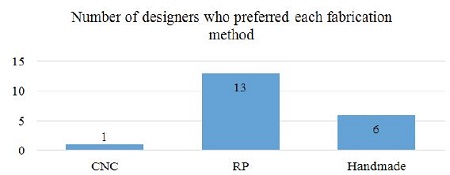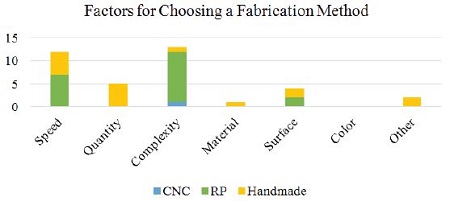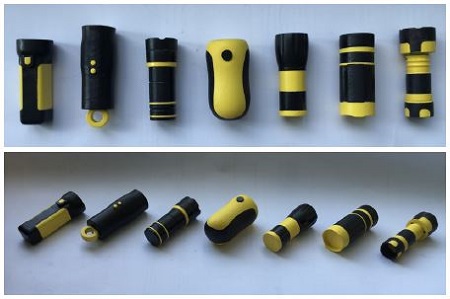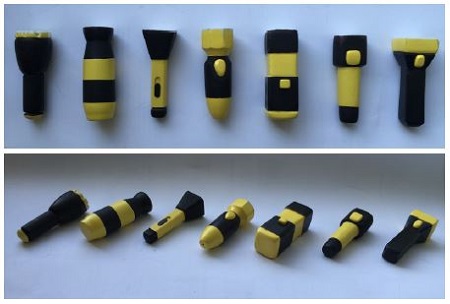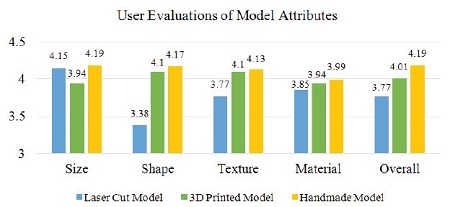
Student perspectives on fabrication methods and design outcomes
Abstract
Background The construction of models is an important component in the innovation and final production phase of a design project. They are the key to testing a concept to identify and correct design or usability problems. Models at each stage of the design process should accurately represent the concept and so it is important to choose fabrication methods that are appropriate for the goals of the model.
Methods This study was divided into two phases. In the first phase 20 industrial deisgn students were tasked to create a mini-flashlight model using one of three randomly assigned fabrication methods: CNC, 3D Printing or handmade. The designers were surveyed before beginning and after finishing the model on their percieved effectiveness of the assigned fabrication technique. In the second phase 40 potential users provided usability evaluations of the models and how well the model represented the intended product.
Results The majority of the design students in this study indicated at the beginning of the study that the fabrication method that they would prefer to use for the project was 3D printing. The students expected that this method would produce the most successful prototype and also that it would be the fastest. At the end of the study the students indicated that 3D printing was neither as successful nor as fast as expected and that handmade methods may have been better. The model evaluators gave the highest ratings to the handmade models, followed closely by the 3D printed models.
Conclusions Most designers will choose a fabrication method based on their own experience. It is important then for design education to ensure that designers get the experience needed to understand that a preferred fabrication method may not always lead to the best outcomes.
Keywords:
Fabrication Methods, Models, Design Stages, New Product Design1. Introduction
Few products can come into being without being preceeded by prototypes or models. New designs are typically accompanied by unforeseen problems because people can cannot know all design issues and challenges before the idea is actually put into practice. Prototypes or models are used to test whether a new design idea is likely to perform as anticipated or to identify problems. Prototyping and modelling during the design process can help designers make adjustments to the design, in terms of materials, size, shape, assembly, color, manufacturability and strength.
Because product design is an iterative and creative process linking design and fabrication processes, designers will generally make more than one model during the process. It is recognized by many researchers that designers need to make models in three stages. The first stage is the evolutionary stage, which helps designers clarify the user requirements. The second stage is the experimental stage. Models are built and evaluated iteratively at this stage. In the last stage, exploratory models are made to modify the existing products.
Fabrication methods have advanced with innovations in technology. From the traditional handmade model making to digital creation, various fabrication methods have been invented that provide designers a tremendous amount of choice in the model-making process. However, more choices for designers also mean that they may have a better or best choice in different stages and for different products. This range of options poses several questions: Will using an inappropriate fabrication technique lead to poor results? Is faster and better? How does one choose the optimum fabrication method for a specific situation?
1. 1. Design Process
New Product design refers a process of creating a brand new product. This innovative process is not simple and involves research, analysis, design studies, engineering and prototyping, testing, modifying and re-testing until the final design has been perfected. Various approaches to organizing these activities have been described. Jones (1984) defined a pattern suggesting a basic structure to the design process of analysis-synthesis-evaluation. The evaluation stage, also the longest stage, involves building models to evaluate the design. A more detailed prescriptive pattern was developed by Archer (1984), who identified six types of activity as Programming, Data collection, Analysis, Synthesis, Development and Communication. Cross (2000) developed a simple four-stage pattern in the design process which includes exploration, generation, evaluation and communication. An iterative feedback loop is shown from the evaluation stage to the generation stage, providing an effective model to evaluate a concept. The end point of the process is the documentation and communication of the design for manufacturing.
The design process aims to define what is required, brainstorm innovative ideas, create new models, evaluate the design and finally generate the product. The process of iteratively refining a design idea, creating a physical model, and then evaluating its outcome to identify improvements is described in five stages of the design process (Figure 1).
Prototype testing refers to creating prototypes to evaluate the improvement of the concept. It has been widely used in almost every product type ranging from dog food to automobiles, from detergents to electron microscopes. It will determine whether the product lives up to its promises, what the potential problems are and how the product can be improved.
1. 2. Physical Models
Constructing models to evaluate and improve concepts is part of design iteration. Models are important tools for improving the quality of design decisions. Though modelling can take a great deal of time, using them to test a concept is the best and most efficient way to obtain answers about conceptual ideas that are clearly wrong.
Designers tend to have a clear idea of how they want a product to work and look. However, new designs are often accompanied with unforeseen problems. Making models to test helps designers know whether a product will actually perform as desired or appear as imagined. Different models can help designers make adjustments to the design, materials, size, shape, assembly, color, manufacturability and strength.
Results derived from testing models provide specific and accurate feedback on how to make improvements to the design. A designer may use 2D sketches as a guide when undertaking sketch modelling, but the technique is particularly suited to interactive design development, where the designer handworks the form until content with its look and feel.
During the prototyping and evaluation stages, different models are built and tested. Most of them are not made the same as the final product and are purpose built to test different aspects of the product. These physical models bring three-dimensional reality to design ideas. For example, a model can be as simple as some sticks inset together. It will have low visual fidelity but may represent the structure very well. In contrast, a 3D printed appearance model that looks the same as the final product may have high visual fidelity but low functional fidelity. Though these two models are made in the prototype stage, each is most effective for two different situations. Not only can designers develop a model that looks like a realistic product, but also have a prototype that works like an elastic product. These dimensions of fidelity are called “visual fidelity” and “functional fidelity”. In other words they are “looks like” and “works like” models.
By varying the attributes along these two dimensions, models may be divided into many types of categories(Figure 2):
Concept model (3D sketch model): A crude physical model is made to demonstrate an idea. Concept models allow designers from different functional areas to understand the idea, stimulate the thoughts and discussion, as well as drive acceptance or rejection.
Design development model: Design development models are used to help understand more about the relations between components, cavities, interfaces, structure and form.
1. 3. Fabrication Methods
An essential step in the design process is building a model to test design variations, test and compare theories, as well as validate design performance. The above has been introduced to determine what type model should be constructed for testing different factors. The remaining problem is determining which fabrication method should be chosen when designers make different models. There are various types of fabrication processes for designers to select from when they are undertaking a project. Each fabrication method has advantages, disadvantages, and unique characteristics. As a designer gains experience and skill over time, their decision will be informed both by previous experience and fabrication goals. A designer may adopt a hybrid approach to meet specific needs. However, generally speaking the four most common fabrication methods might be classified as:
Digital Fabrication
Digital fabrication is defined as a computer-aided processes that manipulates material utilizing subtractive or additive methods. The process is mechanized so that it requires very little additional guidance from the designer during fabrication.
Computer Numerical Control (CNC)
CNC machining produces finished parts from a variety of materials by cutting parts from blocks of the desired material via laser cutting, milling, water jet cutting and other processes. The process begins by 1) preparing a file in the computer, 2) placing the material in the machine, and 3) transferring the file to the fabricating machine. The machine automatically mills or cuts the material according to the computerized directions provided by the user. CNC machining is generally the most accurate prototyping process but requires a long lead time. It can cut materials precisely and produce strong components with good surface finish, thus reducing secondary operations. It’s suitable for functional evaluation and testing.
Rapid Prototyping (RP)
Rapid prototyping is a group of techniques used to quickly fabricate a model. The process steps are as follows: 1) prepare a 3D file for the computer, 2) set up the machine, and 3) send the file to be printed. The machine automatically builds up the material according to the computerized directions it is given. The rapid prototyping process starts with the creation of geometric data, which must represent a valid geometric model. The prepared geometric model is typically sliced into layers, and the slices are scanned into lines and then it builds up a model layer-by-layer.
3D printing is a process of making a three-dimensional solid object of virtually any shape from digital models. Time cost factors depend on the method used, size and complexity of the model. It can print color models. Support material is drawn where needed throughout the process. In the end, the models are formed from a brittle, plaster-like material. This method is not recommended for functional testing because of its inherent weakness.
3D printing offers the fastest build time of any additive process. One characteristic is that it can print colorful models that provide more practical information and aesthetic appeal. The process can form parts with complex geometries. It is a very simple method to create appearance models quickly and efficiently. However, models made by a 3D print process can be rough and fragile. There are relatively few material options and the method provides no insight into the eventual manufacturability of the design. Therefore, 3D printing will not be chosen when designers need a functional or finalized model.
Handmade Model Making
Handmade model making includes using hand tools and conventional machines. Designers must manage the tools by themselves. In this process a model is made without computer assistance. Some people say a handmade prototype is the best method for starting the design process. When compared with digital fabrication, this method is slow but offers more flexibility. When designers make concept models they need to change the model quickly and frequently. Handmade models support this designer requirement. The disadvantages of handmade model formation are that the resulting models may offer low visual and functional fidelity.
1. 4. Objective
The objective of this paper is to investigate the relation between fabrication methods and design outcome. The focus will be on producing appearance models of a specified product. This level of prototype might be used late in the concept development process to help validate characteristics of a design concept prior to the creation of functional production prototypes. Using different methods to build one type of model can lead to different design outcomes and highlight the feasibility of the corresponding fabrication method.
Questions about the relation between fabrication and design outcome in this study:
- 1) Which fabrication method is the best choice for one type of model?
- 2) What factors will influence designers to choose fabrication method?
- 3) Which of the models (produced via different fabrication methods) are most highy rated by end users?
2. Method
This study was divided into two phases. The first phase focused on the actual creation of the models and collecting data on designers’ preferences and perspective on the level of success of the fabrication method. The second phase focused on evaluating the models and collecting data on how accurately the model represents the product from an end user’s perspective.
2. 1. Phase 1 - Model Creation
Twenty college industrial design students volunteered to take part in model creation. All the participants in this study were over the age of eighteen and with basic industrial design knowledge. This helped remove some issues such as not knowing how to build an accurate digital model or how to use required equipment. To ensure all participants had similar levels of industrial design knowledge and similar experiences, only undergraduate senior industrial design students were recruited.
Each designer was given a detailed brief describing the product to be built including: the product name, function, size, color, shape, texture and material. By following a description rather than a picture or a physical product, the designers had some latitude in choosing how to build the model. The work conducted in this study was a stand alone exercise and not connected to any other ongoing design development work.
Each designer was randomly assigned one of three fabrication methods to use: CNC, 3D Printing and Handmade model making. Once assigned a method to use, they were required to complete a pre-survey. Since each designer may have their own preferences and could not choose the fabrication to be used, this survey collected data on how and why they would normally choose a fabrication method. It also asked the designers to evaluate how successful they thought a model built utilizing the assigned fabrication method would be.
Designers were given three weeks to complete the model. They were allowed to plan work on their own schedule. Each designers’ model was photographed weekly and each designer was required to report on their progress weekly. The report included what if any difficulties they ran into; whether the problems had been solved and how they were solved Once finished, the designers turned in their models and completed a post survey where they evaluated the level of difficulty in making the model and identify the most difficult factors that they encountered in constructing it. It also asked them to rate how successful they thought the resulting model from the assigned fabrication method actually was.
2. 2. Phase 2 - Model Evaluation
Forty people aged above eighteen years were recruited to evaluate the models created by the designers. Each evaluator was randomly assigned 5 models. Each model was evaluated independently. Evaluaters were given a description of the product and how it would be used. Evaluators then completed a survey on which they rated each model on a Likert-type scale on topics such as: how well the model matched the product description; how well they liked the model’s appearance; or if the product represented by the model looked easy to use.
3. Results
3. 1. Model Creation Results
The results of model creation include three parts: Pre-survey data, Post-survey data and the physical models that were created. Six participants used laser cutting to build the model. 7 participants made the model by using 3D printing and other 7 participants built the model by using handmade model making.
Pre-survey Results
The pre-survey included six questions. Question one to three asked participants’ personal opinion regarding which fabrication method they wanted to use for making the mini-flashlight model, why they chose this fabrication and the success rate for the fabrication. Figure 3 shows that one participant preferred CNC to build the model due to the complexity of the model. More than a half of participants preferred to employ rapid prototyping to make the mini-flashlight model as they thought that using it to make mini-flashlight would be faster and that this fabrication method would be suitable for the model’s complexity and finish.
After being assigned a fabrication method, the designers were asked to rate how successful they expected the fabrication method would be for building the model. Computer numerical control scored lowest with two designers expecting CNC would be unsuccessful and three expecting it would be neither successful nor unsuccessful. Designers rated rapid prototyping much higher than other fabrication methods with five expecting the model to be “very successful” and two “successful”. For handmade models, four participants expected it to be “successful”, one expecting it to be neither successful nor unsuccessful and two expecting it to be unsuccessful (Figure 4).
Post-survey Results
After making the model, the designers were asked how successful the assigned fabrication method was for building the model (Figure 5). Five designers felt that the model built with CNC was neither successful nor unsuccessful with only two participants indicating that they felt their models were successful. The result was different from the designers’ initial expectations where most expected that rapid prototyping would be the most successful method. The handmade method scored much higher after the models were built than designers expected beforehand. Four designers thought their handmade models were successful and three felt that they were were very successful.
Figure 6 shows the average of the designers’ expectations of creating a successful model with their assigned fabrication method before and after they created the model.
The overall time spent producing each of the models was tracked. Table 1 shows the average time actually spent producing models with each fabrication method. The table also shows the relative speed that designers expected each fabrication method to take before beginning the study.
Figure 7 shows the factors that the designers in this study said that they consider when choosing a fabrication method to use.
Produced Models
The six models in Figure 8 were made by CNC. All the six participants used laser cutting to make the mini-flashlight model. They felt that laser cutting was more efficient compared to other CNC methods because they didn’t need to build the digital 3D model and set up data.
Figure 9 seven shows the models made by rapid prototyping. The most common complaint about this method was the precision of 3D printing. The models were printed on either a Z-Corp 3D printer or a Dimension FDM 3D printer. Almost all of the models were polished. The 3D printed models tended to have more detail which added some increased difficulty in painting.
Figure 10 shows the models created with handmande methods.
3. 2. Model Evaluation Results
The evaluation survey asked participants (potential end users) to evaluate a model on a scale of 1 to 5 with 5 meaning they were very satisfied and 1 meaning they were very dissatisfied. Models were rated based on size, shape, texture, material, and overall rating. Each model was evaluated by ten different participants. Figure 11 shows the average scores. The average of rate for shape is 3.38 point for laser cut models. Evaluators were less satisfied with laser cut models’ shape. Feedback implied that this was due to sharp edges on the models which hurt their hands. The rating of 3D printed models were around 4.00. Participants were generally satisfied with 3D printed models. Handmade models received the highest evaluations. Participants indicated that these models best matched the description of the mni-flashlight
Participants were also asked to evaluate the refinement and appearance of the models. A similar scale was used with 5 meaning that the model was very refined with 1 meaning that the model as very unrefiened. The results are shown in Figure 12. Laser cut models scored lower than models produced via other methods in terms of both revinement and appearance. 3D printed models scored highest (4.13) in refinement. Handmade models scored slightly lower than the 3D printed models in refinement and appearance.
Evaluators next rated models on a scale of 1 to 5 based on how easy it was to understand how the model could be operated. 5 meant that the model was most simple to understand and 1 meant that the model was most difficult to understand (Figure 13). The laser cut and handmade models appeared most simple to understand by simply looking at model. The scores for the 3D printed models were slightly lower indicating that some of the designs may have been more difficult to understand.
Figure 11 also shows the evaluator’s ratings for ease of use. These scores were similar to the ease of operation. 3D printed models again scored lowest with evaluators commenting that on some of the designs the on/off button was hard to find or that they were not sure whether part of the model was or was not supposed to be a button. Finally, ease of use was also evaluated with similar evaluations of all models.
4. Discussion
Prior to the study, the fabrication method expected to be most preferred by designers was handmade model making. However, rapid prototyping was initially rated very highly by the designers but the results of the finished models was lower than their expectations. CNC and handmade methods were initially rated lower but the final models produced surpassed the designer’s expectations with the results of the handmade models ultimately being rated most successful by their designers.
Prior to building the models, the designers in the study also thought that rapid prototyping would be the fastest method followed by handmade methods and CNC being the slowest. After the models were produced, it turned out that handmade methods were fastest followed by rapid prototyping and CNC.
At the beginning of the study more than half of the designers indicated that they would prefer to use rapid prototyping to make their models and thought that RP models would be very successful. After the models were produced, the handmade models were rated most successful by the designers and appeared to the most time efficient.
Designers in this study indicated that the complexity of the design and the time needed to produce a model were the most important factors (see Figure 7). Designers felt that the mini-flashlight in this study had some complexity and so wanted to use rapid prototyping which can build complicated models quickly and easily. The quantity (or total number of models that needed to be made) also influenced the designers. Five of the designers from the start preferred to make the model by hand because they just need to build one.
From the perspective of the designers, rapid prototyping was initially preferred, but handmade methods appeared to be the best for making the mini-flashlight. From a user’s perspective, the handmade models also scored highest in terms of most aspects, such as size, shape, material, texture and overall score. 3D printed models did score well with users, getting the highest evaluation scores for refinement and appearance (though were very similar to the handmade model scores). Overall handmade methods seemed to produce the most successful models from a user perspective as well.
As the designers in this study were senior undergraduate design students, this study may have some implications for design education. It is important that students gain exposure to and experience with a wide variety of fabrication methods. This will allow them to gain a practical understanding of the advantages, disadvantages and time involved with each. It will also allow them to tailor their own approach to modeling as their personal skills and experience grow to utilize multiple fabrication methods to achieve required results.
5. Conclusion
The construction of models is an indispensable component in the innovation and production phase of a design project. The objective of this paper was to figure out the relation between fabrication method and representativeness of a model by focusing on these questions: Which fabrication method is the best choice for one type of model? What factors will influence designers’ choice about fabrication method? What are the opininon of the various models from a user’s (non-designer’s) perspective?
Most designers would have preferred to use 3D printing to formulate the mini-flashlight appearance model. However, handmande methods scored very highly, were the most time efficient and were most highly rated by end users. Most designers will choose a fabrication method based on their own experience. It is important then for design education to ensure that designers get the experience needed to understand that a preferred fabrication method may not lead to the best outcomes.
Notes
This is an Open Access article distributed under the terms of the Creative Commons Attribution Non-Commercial License (http://creativecommons.org/licenses/by-nc/3.0/), which permits unrestricted educational and non-commercial use, provided the original work is properly cited.
References
- Archer, L. B. (1974). Design Awareness and Planned Creativity in Industry. Dunfermline, United Kingdom: Better World Books Ltd.
-
Asberg, B., Blanco, G., Bose, P., Garcia-Lopez, J., Overmars, M., Toussaint, G., Wilfong, G., & Zhu, B. (1997). Feasibility of design in stereolithography. Algorithmica,19(1), 61-83.
[https://doi.org/10.1007/PL00014421]

- Beecher, F. (2009). Integrating Prototyping Into Your Design Process. Retrieved October, 2013, from http://boxesandarrows.com/integrating-prototyping-into-your-design-process.
- Budde, R., Kautz, K., & Kuhlenkamp, K. (1992). Prototyping: An Approach to Evolutionary System Development. Berlin: Springer-Verlag.
- Cross, N. (2000). Engineering Design Methods : Strategies for Product Design. New York: Wiley.
-
Evans, M., & Campbell, R. (2003). A comparative evaluation of industrial design models produced using rapid prototyping and workshop-based fabrication techniques. Rapid Prototyping Journal, 9(5), 344-351.
[https://doi.org/10.1108/13552540310502248]

- Evans, M., & Wormald, P. (1993). The future role of virtual and physical modelling in industrial design. International Confererence on Design and Technoloty Educational Research and Curriculum Development (IDATER 93).
- Kocabiyik, E. (2004). Engineering Concepts in Industrial Product Design With A Case Study of Bicycle Design (Master's thesis). Graduate School in Partial Fulfillment. Retrieved 2013, from http://library.iyte.edu.tr/tezler/master/endustriurunleritasarimi/T000262.pdf.
- Learndon. (2013). What is a Production Prototype?. Retrieved October, 2013, from .
- Monosoff, T. (2013). Creating a Product Prototype. Retrieved October, 2013, from http://www.entrepreneur.com/article/80678.
-
Ozer, M. (1999). A Survey of New Product Evaluation Models. Journal of Product Innovation Management, 16(1), 77-94.
[https://doi.org/10.1111/1540-5885.1610077]

-
Perrottet, D., Housh, R., Richerzhagen, B., & Manley, J. (2005). Heat damage-free Laser-Microjet cutting achieves highest die fracture strength. Lasers and Applications in Science and Engineering. International Society for Optics and Photonics, 285-292.
[https://doi.org/10.1117/12.586710]

- Petroski, H. (1996). Invention by Design: How Engineers Get from Thought to Thing. Cambridge: Harvard University Press.
- Phillips. (2009). Choosing the Right Rapid Prototype Source for Your Product Development Program. Retrieved October, 2013, from http://www.phillipsmedisize.com/sites/default/files/whitepaper/Prototyping%20White%20Paper.pdf.
- Prinz, F., Merz, R., & Weiss, L. (1997). Building Parts You Could Not Build Before. Proceedings of the 8th International Conference on Production Engineering, (pp.40-44).
- Protolabs. (2013). Prototyping Process: Choosing the Best Process for your Project. Retrieved October, 2013, from http://www.protolabs.com/documents/united-states/pl_ppwp_final.pdf.
- Riley Enterprises. (2013). Product Design & Development: The Generic Process for Developing New Products. Retrieved October, 2013, from http://www.rqriley.com/pro-dev.htm.
- Sculpeto. (2013). 3D Printing. Retrieved October, 2013, from http://www.sculpteo.com/en/help/#object-maximum-size.
- Seely, J. (2004). Digital fabrication in the architectural design process. Retrieved May, 2015, from http://dspace.mit.edu/handle/1721.1/27030.
- Stoll, H. (1999). Product Design Methods And Practices. New York: Marcel Dekker.
- Tovey, M. (2015). Design Pedagogy : Developments In Art And Design Education. UK: Ashgate Publishing, Ltd.
- Urban, G. L., & Hauser, J. R. (1993). Design and Marketing of New Products. Englewood Cliffs, NJ: Prentice-Hall.
- Vorel. (2013). Prototyping. Retrieved October, 2013, from http://www.vorelco.com/services/prototyping.
- Wilson, D. W., Bailey, L. E., & Bennett, C. E. (2000). Expanding mechanical design and fabrication horizons. Johns Hopkins APL Technical Digest, 21(4), 506-515.
-
Yang, M. C. (2005). A study of prototypes, design activity, and design outcome. Design Studies, 26(6), 649-669.
[https://doi.org/10.1016/j.destud.2005.04.005]

- Zurb. (2013). Design Process. Retrieved Octeber, 2013, from http://zurb.com/word/design-process.


